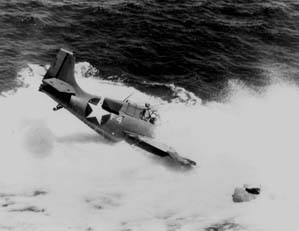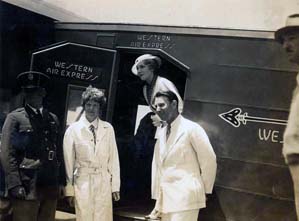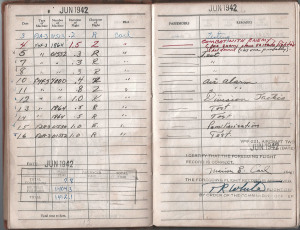
“Bluebird” Harks Back to Naval Aviation’s Earliest Days
In the annals of American invention, some of the nation’s signature creations have emerged from the unlikeliest of locations and that is certainly true of the airplane, a notable example being the Wright Brothers, who built their first aircraft on the second floor of their bicycle shop in Dayton, Ohio. After their successful demonstration of ...

The Birth of the “Dilbert Dunker”
Whether they loved it or hated it, the thousands of naval aviators who rode the “Dilbert Dunker” owed the experience to a Massachusetts Institute of Technology engineer. Although it was Hollywood that introduced the device to the general public in the motion picture An Officer and a Gentleman, for generations of naval aviation personnel the ...

Training the Doolittle Raiders
On April 18, 1942, the Doolittle Raiders launched from the deck of the aircraft carrier Hornet (CV 8) on their famous raid over Japan, two naval aviators having played important roles in getting them to that moment… In June 1942, while visiting the North American Aircraft Company, Brigadier General James H. Doolittle played to his ...

Naval Aviation and the Search for Amelia Earhart
In July 1937, U.S. Naval Aviation played a major role in the wide-ranging but ultimately fruitless search for famed aviatrix Amelia Earhart and her navigator, Fred Noonan. Amelia Earhart was one of the stars that sparkled in the Golden Age of Aviation and her disappearance in July 1937, has remained one of history’s enduring mysteries. ...

Memories of Midway
In the annals of history, there have been great battles fought in nondescript locations, an epic struggle of arms elevating Gettysburg and Waterloo into places of prominence. Such was the case in the U.S. Navy’s most celebrated victory, a small atoll called Midway the focus of an attack by ships of the Imperial Japanese Navy ...

Taxiing into History
The museum’s example of the SP-5B Marlin holds a distinct place in naval aviation history in that it made the last operational flight of a Navy flying boat in 1967. Yet, seven years earlier, the crew of another Marlin achieved some notoriety in a way that only a flying boat could. In February 1960, P5M-2 ...

Log Book Details Chapter of Museum Skyraider’s Service
The aircraft displayed in the museum not only serve to represent the histories of the types flown by naval aviators over the course of more than a century, each has its own story. In most cases the museum’s files hold very little information about the individuals who manned the cockpits of the aircraft in the collection ...

One Carrier’s Battle at Leyte Gulf
The collection of the National Naval Aviation Museum contains thousands of mementos of war. This includes old uniforms and letters describing momentous events in military history. Among the items are some jagged pieces of metal recovered from USS Kalinin Bay (CVE 68) after one of the most momentous battles of World War II. Baby Flattop ...

Flight Clothing Evolution
The old saying “the clothes make the man” refers to appearance. However, when the Navy’s first aviator, Lieutenant Theodore G. “Spuds” Ellyson, wrote a letter to the Navy Department about flight clothing on September 16, 1911, he sought function over form. The Navy previously outlined the requirements for flight clothing. Officers specified a helmet with ...

The Other D-Day of June 1944
When anyone with even a passing interest in World War II history thinks of June 1944, the day that automatically comes to mind is June 6th, D-Day. On that day Allied forces landed in Normandy. Yet, for naval aviation, the Battle of the Philippine Sea was equally important. Hellcats Hunt Turkeys The action was the ...

Tomcats Battle Floggers
Thirty years ago, just weeks away from the inauguration of his successor (and Vice President), President Ronald Reagan received word of air combat action over the Gulf of Sidra, the latest chapter in a longstanding standoff with Libyan dictator Muammar Qaddafi lasted his entire presidency. On January 4, 1989, a pair of F-14 Tomcats assigned ...

The N-9 Trainer
When the United States entered World War I, the Navy’s aviation resources included 300 officers and enlisted men on duty and just 58 aircraft of all types. Among the assortment of flying machines was the N-9. It served as the platform for the training of the World War I generation of aviators as well as ...

Magic Carpet Ride
In December 1945, newspapers that just one year before had brought news of the bitter fighting in the Ardennes, the famed Battle of the Bulge, printed the best Christmas gifts those on the home front could receive. “Cpl. James H. Mason, son of Mrs. Mary J. Mason… is on his way home,” read the hometown ...

Keeping Score
Whether looking though a newspaper or browsing the website of a favorite team, baseball fans past and present have awakened each day during the season to check the box scores for their favorite team, the statistical summary telling the tale of the previous day’s game. Aircraft carriers of World War II and later conflicts had ...

A Blue Angel’s First Combat Flight at Midway
In famous director John Ford’s color film titled The Battle of Midway, an eighteen minute documentary that captures events of the landmark battle that took place in June 1942, one of the scenes shows naval aviators walking from a PBY Catalina to a waiting ambulance. Among them is a dark-haired pilot in a khaki flight ...

Marine Fighter Ace Scores First Kill at Midway
At one of the symposiums held at the National Naval Aviation Museum some years back, retired Commander Alex Vraciu, one of Navy’s storied fighter aces of World War II, relayed a story about a postwar flight from Naval Air Station (NAS) Patuxent River, Maryland, during which he spotted another Navy aircraft and initiated a mock ...

Foreshadowing Midway
The photograph taken at Pearl Harbor on May 27, 1942, is filled with historical significance. There is the setting, the flight deck of the aircraft carrier Enterprise (CV 6), destined to be the most decorated ship of World War II, with the destruction wrought by Japanese aircraft on Battleship Row visible in the background. The ...

“Fifi” Has Early Ties to Museum
The museum’s “FF-1″ is actually an export version of the aircraft designated the G-23 built by Canadian Car & Foundry under rights acquired from Grumman Aircraft Engineering Corporation. It was the sole example purchased by the Nicaraguan government, one of three different aircraft procured to form the basis of that nation’s air force. After seeing ...

Museum’s OV-10 Bronco is Memorial to Fallen Naval Aviator
On January 3, 1969, in a ceremony held on board Naval Air Station (NAS) North Island, California, the Navy established its first fixed-wing light attack squadron, VAL-4, squadron members adopting the nickname “Black Ponies.” The squadron, like Helicopter Attack Squadron Light (HAL) 3, established in 1967, was brought into existence to fulfill a tactical requirement ...

The Faces of Midway
Whether they strapped into cockpits of airplanes on the sandy shores of Midway Atoll or on the wooden planks of carrier decks, a select group of young men faced a daunting prospect in early June 1942. Bearing down on them was a mighty Japanese Fleet, some of the ships of which had last ventured this ...